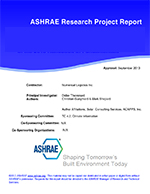Description
Many studies report that adverse health effects are most strongly correlated with fine particulate matter (< 2.5 µm in diameter), originating from ambient emissions mainly derived from fossil fuel combustion. This study examines the infiltration of ultrafine (< 0.1 µm) and fine particulate matter (< 1.0 µm) into indoor environments including typical office space and elementary schools. With the use of an Ultra High Sensitivity Aerosol Spectrometer and an Aerosol Mass Spectrometer, the size and chemical speciation of ultrafine and fine particulate matter were measured as a function of time. Results showed that the ratio of indoor to outdoor ultrafine particulate matter is highly dependant on the amount of ventilation provided to the indoor environment, namely the specific building characteristics and the HVAC system usage. Additionally, the indoor exposure to ammonium nitrate particles was found to be minimal. This study provided important data needed to understand exposure and health risks associated with inhalation of fine particulate matter, and to improve understanding of filtration requirements in mechanically ventilated buildings. The correlation of indoor to outdoor particulate concentrations can be used to evaluate the performance of HVAC systems in conditioning indoor environments with an air quality perspective.
Units: SI
Product Details
- Published:
- 2006
- Number of Pages:
- 182
- File Size:
- 1 file , 13 MB
- Product Code(s):
- D-RP-1281




